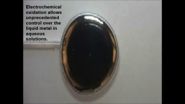'Femme fatale' emerald ash borer decoy lures and kills males
2014-09-15
(Press-News.org) An international team of researchers has designed decoys that mimic female emerald ash borer beetles and successfully entice male emerald ash borers to land on them in an attempt to mate, only to be electrocuted and killed by high-voltage current.
"Our new decoy and electrocution process may be useful in managing what the U.S. Department of Agriculture Forest Service claims to be the most destructive forest pest ever seen in North America," said Michael Domingue, postdoctoral fellow in entomology, Penn State.
According to the Forest Service, the emerald ash borer was introduced to the United States from China in 2002. Since then, it has spread throughout 24 states and two Canadian provinces, and killed tens of millions of otherwise healthy native ash trees.
"Early detection of the pest in traps such as ours can help in coordinating management strategies to slow its spread and minimize its impact," said Domingue.
The researchers -- including entomologists and engineers at Penn State, the Hungarian Academy of Sciences, the Forest Research Institute in Matrafured, Hungary, and the USDA -- created the decoys using a bioreplication process with nanoscale fidelity.
"Specifically, we coated a dead female beetle with a vapor of nickel, and used the 'nickelized' shell to fabricate two matching molds in the shape of a resting beetle," said Akhlesh Lakhtakia, Charles Godfrey Binder professor of engineering science and mechanics, Penn State. "Pressing a structurally colored plastic sheet between the two molds while simultaneously applying heat, we cast numerous replicas or decoys. The finished bioreplicated decoys retained the surface texture of the beetle at the nanoscale.
Additionally, we painted some decoys a metallic green."
The Penn State engineers also created decoys using a 3D-printing process. In this method, they molded plastic into the size and shape of emerald ash borers, but did not attempt to duplicate the surface texture of the insects.
Next, the entomology researchers pinned the bioreplicated and 3D-printed decoys, as well as dead female emerald ash borers, onto leaves in forests in Hungary to see which of them best attracted wild males. In the same forests, the team also placed traps configured with decoys bearing a 4,000-volt charge to electrocute and trap males as they landed on the decoy females.
The results will appear today (Sept. 15) in the Proceedings of the National Academy of Sciences.
The scientists found that both types of synthetic decoys, as well as the dead pinned females, elicited initial flights by males toward them. Males nearly always chose to land on the dead females and the more realistic bioreplicated decoys. However, while the males initially flew toward the simpler 3D-printed decoys, they did not land on them. Males would normally quickly leave the bioreplicated decoys after they touched them. Yet, that brief contact was enough for them to become instantly stunned and captured by the trap if the voltage was applied to the decoys.
According to Domingue, the light-scattering properties of the beetle's shell -- which the team experimentally demonstrated using a white laser -- made the nano-bioreplicated decoys more lifelike and, therefore, more attractive to males than the non-textured 3D-printed decoy.
"We learned that not only do color and shape of a resting female beetle play a role in attracting males to a mate, but also the fine-scale texture of the visible surface is important," said Domingue. "Small bumps and spines on the outer surface of their wings and heads that aren't visible to the human eye scatter light in a distinctive pattern. Beetles appear to be able to recognize this feature of the decoys and are strongly attracted to it. This insight may at least partially explain how mate-seeking males can easily detect and approach green-colored females cryptically resting on green leaves. Ultimately, we have gained new insights into how to manipulate the behavior of emerald ash borers and similar pests in ways that can help to trap them and monitor where they might be doing damage."
According to Thomas C. Baker, distinguished professor of biology, Penn State, the findings were possible only because of the multidisciplinary makeup of the team.
"I was able to find colleagues whose intellects, expertise, and enthusiasm matched the tasks at hand, thus enabling us to figure out how these destructive beetles find each other to mate and how we can exploit this behavior in order to help APHIS meet its goals of early detection and mitigation of invasive pests," he said.
The researchers said their next step will be to further improve the traps to maximize their potential as part of an early detection tool for emerald ash borers.
"Our laboratory has ongoing research with the USDA Animal Plant Health Inspection Service into remote-reporting, Internet-based technologies, and we will be working to couple this research with our ash-borer detection technique so that activity of the pest can be reported and assessed immediately by APHIS personnel, rather than waiting days or weeks until a trap might usually be checked," said Baker.
In addition, the team has been investigating the use of the decoys to attract other insect species, some of which are aggressive feeders on oak trees in central Europe and might threaten North American oaks in urban and forest landscapes much as the emerald ash borer destroyed ash trees.
"We have made progress in our research so far in Hungary these past few summers, and it looks like our decoys can be refined to attract and detect these other, new and potentially invasive pest species effectively," said Domingue.
INFORMATION:
Other authors on the paper include Drew Pulsifer, recent graduate student in engineering science and mechanics; Loyal Hall, graduate student in entomology; John Badding, professor of chemistry; Jesse Bischof, graduate student in chemistry; Raul Martin-Palma, adjunct professor of materials science and engineering; and Missy Hazen, research technologist, Huck Institutes of the Life Sciences; all of Penn State; and Zoltan Imrei of the Hungarian Academy of Sciences, Gergely Janik of the Forest Research Institute in Matrafured, Hungary, Victor Mastro of the USDA.
The USDA and the Hungarian Academy of Sciences supported this research.
ELSE PRESS RELEASES FROM THIS DATE:
Researchers control surface tension to manipulate liquid metals
2014-09-15
VIDEO:
Liquid metals have very large surface tensions that causes them to assume a spherical shape. Researchers have shown that the deposition of a surface oxide lowers the surface tension...
Click here for more information.
Researchers from North Carolina State University have developed a technique for controlling the surface tension of liquid metals by applying very low voltages, opening the door to a new generation of reconfigurable electronic circuits, antennas and other ...
Neuroscientists identify key role of language gene
2014-09-15
CAMBRIDGE, MA -- Neuroscientists have found that a gene mutation that arose more than half a million years ago may be key to humans' unique ability to produce and understand speech.
Researchers from MIT and several European universities have shown that the human version of a gene called Foxp2 makes it easier to transform new experiences into routine procedures. When they engineered mice to express humanized Foxp2, the mice learned to run a maze much more quickly than normal mice.
The findings suggest that Foxp2 may help humans with a key component of learning language ...
Network measures predict neuropsychological outcome after brain injury
2014-09-15
Cognitive neuroscience research has shown that certain brain regions are associated with specific cognitive abilities, such as language, naming, and decision-making.
How and where these specific abilities are integrated in the brain to support complex cognition is still under investigation. However, researchers at the University of Iowa and Washington University in St. Louis, Missouri, believe that several hub regions may be especially important for the brain to function as an integrated network.
In research published online Sept. 15 in the Early Edition of the Proceedings ...
Cells simply avoid chromosome confusion
2014-09-15
Reproductive cell division has evolved a simple, mechanical solution to avoid chromosome sorting errors, researchers report in the Sept. 11 Science Express.
This natural safeguard prevents incorrect chromosome counts and misalignments that lead to infertility, miscarriage, or congenital conditions.
"Mistakes during reproductive cell division cause these problems, but what exactly goes wrong is often not understood," said Adele Marston of the Wellcome Trust Center for Cell Biology at the University of Edinburgh in Scotland and lead author of the study. Understanding ...
NASA's TRMM satellite sees Hurricane Odile strike Baja California
2014-09-15
VIDEO:
This animation of NOAA's GOES-West satellite imagery from Sept. 13 through Sept. 15 shows Hurricane Odile's movement and landfall near Cabo San Lucas on Mexico's Baja California. TRT 0:42...
Click here for more information.
NASA's Tropical Rainfall Measuring Mission satellite known as TRMM captured data on powerful Hurricane Odile revealing heavy rainfall from powerful thunderstorms as it made landfall in Baja California. Odile tied a record for strongest hurricane to hit ...
IU study: Combining epilepsy drug, morphine can result in less pain, lower opioid doses
2014-09-15
INDIANAPOLIS -- Adding a common epilepsy drug to a morphine regimen can result in better pain control with fewer side effects. Moreover, the combination can reduce the dosage of the opioid needed to be effective, according to a team of pain researchers at Indiana University.
The result could bring significant relief to many patients with neuropathic pain, a difficult-to-treat condition often felt in the arms and legs and associated with nerve tissue damage.
"There is a huge unmet need for better treatments for neuropathic pain," said Fletcher A. White, Ph.D., the Vergil ...
'Squid skin' metamaterials project yields vivid color display
2014-09-15
The quest to create artificial "squid skin" -- camouflaging metamaterials that can "see" colors and automatically blend into the background -- is one step closer to reality, thanks to a breakthrough color-display technology unveiled this week by Rice University's Laboratory for Nanophotonics (LANP).
The new full-color display technology uses aluminum nanoparticles to create the vivid red, blue and green hues found in today's top-of-the-line LCD televisions and monitors. The technology is described in a new study that will be posted online this week in the Early Edition ...
Researchers discover new producer of crucial vitamin
2014-09-15
New research has determined that a single group of microorganisms may be responsible for much of the world's vitamin B12 production in the oceans, with implications for the global carbon cycle and climate change.
Although vitamin B12 is an essential molecule required by most life on this planet, it is only produced by a relatively small group of microorganisms because it is so large and complex. For humans, vitamin B12 plays a key role in maintaining the brain and nervous systems, as well as DNA synthesis in cells throughout the body.
Professors Andew Doxey and Josh ...
X-rays unlock a protein's SWEET side
2014-09-15
Sugar is a vital source of energy for both plants and animals alike.
Understanding just how sugar makes its way into the cell could lead to the design of better drugs for diabetes patients and an increase in the amount of fruits and vegetables farmers are able to grow. Stanford University researchers have recently uncovered one of these "pathways" into the cell by piecing together proteins slightly wider than the diameter of a strand of spider silk.
To determine the size, shape and orientation of one of the newest (and smallest) of these proteins, the sugar transporter, ...
Pitt chemical biologist finds new halogenation enzyme
2014-09-15
PITTSBURGH—Molecules containing carbon-halogen bonds are produced naturally across all kingdoms of life and constitute a large family of natural products with a broad range of biological activities. The presence of halogen substituents in many bioactive compounds has a profound influence on their molecular properties.
One of the Holy Grails in chemical science has been to find the late-stage, site-specific incorporation of a halogen atom into a complex natural product by replacing an sp³ C-H bond (one of the most inert chemical bonds known in an organic compound) with ...



